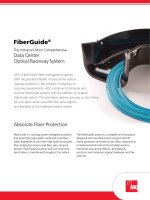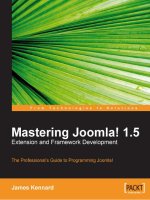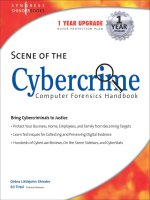The Hacker’s Underground Handbook
Bạn đang xem bản rút gọn của tài liệu. Xem và tải ngay bản đầy đủ của tài liệu tại đây (2.51 MB, 116 trang )
1
The Hacker’s Underground Handbook
Learn What it Takes to Crack Even the Most Secure Systems
By: David Melnichuk
2
Copyright Notice
This report may not be copied or reproduced unless specific permissions
have been personally given to you by the author David Melnichuk. Any
unauthorized use, distributing, reproducing is strictly prohibited.
Liability Disclaimer
The information provided in this eBook is to be used for educational
purposes only. The eBook creator is in no way responsible for any misuse of the
information provided. All of the information in this eBook is meant to help the
reader develop a hacker defense attitude in order to prevent the attacks
discussed. In no way should you use the information to cause any kind of
damage directly or indirectly. The word “Hack” or “Hacking” in this eBook
should be regarded as “Ethical Hack” or “Ethical hacking” respectively.
You implement the information given at your own risk.
© Copyright 2008 Learn-How-To-Hack.net. All Rights Reserved.
3
Table of Contents
A. Introduction..............................................................................................5
1. How can I use this eBook?
2. What is a hacker
3. Hacker Hierarchy
4. What does it take to become a hacker?
5. Disclaimer
B. Programming............................................................................................9
1. Do I really need it?
2. Where should I start?
3. Best way to learn
C. Linux.......................................................................................................12
1. What is it?
2. Choosing a distribution
3. Running Linux
4. Learning Linux
D. Passwords...............................................................................................33
1. Password Cracking
2. Phishing
3. Countermeasures
4. More Programs
E. Network Hacking.....................................................................................48
1. Foot printing
2. Port Scanning
3. Banner Grabbing
4. Searching for Vulnerabilities
5. Penetrating
6. Countermeasures
F. Wireless Hacking.....................................................................................70
1. Scanning for Wireless Networks
2. Cracking WEP
3. Packet Sniffing
4
4. Countermeasures
G. Windows Hacking...................................................................................79
1. NetBIOS
2. Cracking Windows Passwords
3. Countermeasures
H. Malware.................................................................................................93
1. Definitions
2. ProRat
3. Countermeasures
I. Web Hacking.........................................................................................104
1. Cross Site Scripting
2. Remote File Inclusion
3. Local File Inclusion
J. Conclusion............................................................................................114
1. Congratulations
2. Keep Learning
3. www.MrCracker.com
5
Chapter One
Introduction
6
How can I use this eBook?
Congratulations! By purchasing this eBook, you have taken your first step
in the exciting process of becoming a Master Hacker. The knowledge you acquire
from this eBook can be put to use in many ways:
• With the ability to think like a hacker, you’ll be able to protect yourself
from hackers attacking you.
• You may wish to seek a career in Ethical Hacking – Usually hired by an
organization, an ethical hacker uses the same tools and techniques as a
hacker to find and secure vulnerabilities in computer systems.
o
o
• Show off your newfound skills to your friends, and just hack because you
want to. It’s FUN!!
What is a hacker?
A hacker is someone who likes to tinker with electronics or computer
systems. Hackers like to explore and learn how computer systems work, finding
ways to make them do what they do better, or do things they weren’t intended to
do. There are two types of hackers:
White Hat – These are considered the good guys. White hat hackers don’t use
their skills for illegal purposes. They usually become Computer Security experts
and help protect people from the Black Hats.
Black Hat – These are considered the bad guys. Black hat hackers usually use their
skills maliciously for personal gain. They are the people that hack banks, steal
credit cards, and deface websites.
These two terms came from the old western movies where the good guys wore
white hats and the bad guys wore black hats.
7
Now if you’re thinking, “Oh boy! Being a black hat sounds awesome!”, Then I have
a question for you. Does it sound cool to live in a cell the size of your bathroom
and be someone’s butt buddy for many years? That’s what I thought.
Hacker Hierarchy
Script kiddies – These are the wannabe hackers. They are looked down upon in
the hacker community because they are the people that make hackers look bad.
Script kiddies usually have no hacking skills and use the tools developed by other
hackers without any knowledge of what’s happening behind the scenes.
Intermediate hackers – These people usually know about computers, networks,
and have enough programming knowledge to understand relatively what a script
might do, but like the script kiddies they use pre-developed well-known exploits
(-
a piece of code that takes advantage of a bug or vulnerability in a piece of software that allows
you to take control of a computer system)
to carry out attacks
Elite Hackers – These are the skilled hackers. They are the ones that write the
many hacker tools and exploits out there. They can break into systems and hide
their tracks or make it look like someone else did it. You should strive to
eventually reach this level.
What does it take to become a hacker?
Becoming a great hacker isn’t easy and it doesn’t happen quickly. Being
creative helps a lot. There is more than one way a problem can be solved, and as
a hacker you encounter many problems. The more creative you are the bigger
chance you have of hacking a system without being detected. Another huge
8
quality you must have is the will to learn because without it, you will get
nowhere. Remember, Knowledge is power. Patience is also a must because many
topics can be difficult to grasp and only over time will you master them.
9
Chapter Two
Programming
10
Do I Really Need It?
You might be asking yourself, do I even need to learn a programming
language? The answer to that is both yes and no. It all depends on what your
goals are. Nowadays, with all the point and click programs out there, you can be a
fairly good ethical hacker without knowing any programming. You can do some
effective hacking if you understand all of the security tools very well. Even if you
understand what’s going on in the background of these programs, most people
will still classify you as a script kiddie. Personally I think you should learn some
programming. Even if it’s the very basics, it’ll give you a much better
understanding of what’s going on. Also, once you learn how to program well,
you’ll be able to develop your own exploits, which is great in many ways:
1. You’ll be considered an elite hacker.
2. Imagine a black hat discovers a vulnerability and codes an exploit for it
that no one else knows about. The black hat would be able to take down
thousands of machines before anyone discovers and patches the
vulnerability.
3. You will feel so much more satisfied having created your own program
or exploit. I promise you this.
So my advice is, don’t settle for being a point and click hacker. Take some time to
understand even just the basics of programming and an entire new world of
hacking will open up to you.
Where should I start?
Many people finally decide that they are going to begin learning a
programming language, but don’t know where to start. I believe that before you
begin to learn a programming language, you should first master HTML (HyperText
Markup Language). HTML is part of what makes up all of the website pages you
see on the internet. HTML is very easy to learn and it’ll get you used to looking at
source code.
11
From there I would suggest starting your programming life with C. C is one
of the most popular languages, and it is what makes up the majority of the
exploits out there today. C also makes up some of the most powerful hacking
programs and viruses that are out there today.
Best way to learn
So how should I go about learning the programming language of my choice?
1. Purchase a beginners book on your programming language. Before you
choose the book, make sure you read the reviews to make sure it’s a
good choice.
2. It is important that once you begin learning the programming language
through your book, you don’t take big breaks. Taking long breaks will
cause you to forget things you learned in the beginning that apply to the
rest of the book.
3. Do ALL of the practice problems provided in the book. The only way you
will become better is by applying what you learn.
4. When something difficult comes up or something that makes no sense
to you, don’t avoid or skip it. Instead embrace it! This is how you
actually learn. If you still don’t understand it after going over it multiple
times, find someone that can help you.
5. Join a programming forum. Search for a website on your programming
language that has a large user base. There will be many professionals on
there that will be able to help you when you get stuck.
6. Practice. Practice Practice. Think of ideas for fun programs that you
could make and program them!
12
Chapter Three
Linux
13
What is it?
Linux is a free, open-source, UNIX-like operating system. As you continue to
learn how to hack, you will realize how important it is to learn how to use the
Linux operating system. Need some convincing? Here are a couple facts:
1. Millions of servers on the internet run on the Linux operating system.
You must learn the operating system to be able to penetrate these web
servers.
2. Some of the best hacking programs only run on Linux.
Choosing a distribution
A Linux distribution is the Linux kernel (-
central component of an operating
system.
) plus a collection of applications. If you are a beginner to Linux, I would
suggest starting with
Ubuntu as your first Linux distribution. It is simple to install
and very user friendly. To see a full list of the most popular distributions can go to
.
Running Linux
There are many ways to get Linux up and running. I will show you the most
popular methods below.
Live CD’s are usually used to test and play around with a Linux distribution.
With a Live CD, you do not have to install the OS (operating system) onto your
hard drive because it runs off the disc on boot. Because it is running off a disc, you
won’t be able to permanently modify any system files. Everything you do will be
stored temporarily in your RAM. Below are the steps to create a Live CD.
Live CD
14
1. Download the Ubuntu Live CD .iso file from www.ubuntu.com .
15
2. Download and install IsoRecorder at
/>
and burn
the Ubuntu .iso file onto a blank CD with the software.
16
Once you have downloaded and installed the IsoRecorder software
locate the Ubuntu image file, right click and select Copy image to CD
and follow the rest of the steps shown in the image.
17
3. Restart the computer with the newly made CD in the CD-ROM.
If your computer doesn’t boot from the CD and continues into Windows, you
must change your computer’s boot order. You can do this by restarting your
computer and going into BIOS. You get there by hitting the correct key constantly.
If you see the Windows screen, it means you missed it. The key varies from
system to system. Usually it is a function key such as F10. It may also be the DEL
or ESC key. The key should be shown on your screen immediately after you boot
up your computer. It is usually the key pointing to “Setup”.
18
Picture property of www.cyberwalker.com
Once you are in the BIOS, select “Boot Sequence” and make sure CD-ROM is set
to the first one. If it’s not, move it up. All what this does is makes sure your CD-
ROM boots before your hard drive.
19
Picture property of www.cyberwalker.com
Picture property of www.cyberwalker.com
If all went well, you should see the Ubuntu boot options screen.
20
You will first see a window full of countries. Once you select yours you will see the
main Ubuntu screen. From here choose the first option to try Ubuntu without any
risks. Once the Ubuntu desktop has loaded and you decide you like what you see,
you have the option to install it by clicking on the install button on the desktop.
Wubi is my favorite option. With the Wubi installer you can install
and uninstall Ubuntu as any other Windows application. You can use the
Live CD version to install Wubi if you followed the steps above and
downloaded it. Or you can download the full 5 gigabyte version from
Wubi
.
1. If you downloaded the full 5 gigabyte file, double click it to run it. If you
are using the previously downloaded Live CD version, then insert your
Ubuntu Live CD. A Ubuntu CD menu should come up.
21
2. Choose: Install inside Windows
3. In the next window, choose the appropriate options and click install.
22
4. Wait for it to fully install and hit finish. Simple, eh?
23
5. Reboot the computer. Before Windows loads, a screen will come up that
gives you an option to boot into Windows or Ubuntu. Arrow down to
Ubuntu and hit <ENTER>.
6. Ubuntu will begin to load. Since this is your first time starting Ubuntu, it
will install and configure a bunch of things, and restart again.
7. Boot into Ubuntu again and you’re good to go!
This is by far my favorite way to run any Linux distribution if I just want to
try it out. With VirtualBox you can run Linux within a Windows or Mac computer.
VirtualBox
1. First download VirtualBox at
.
2. Install it.
3. Open it up and click New on the top.
4. Hit Next.
24
5. Name it and choose Ubuntu from the drop-down list.
6. Choose the amount of RAM you would like to dedicate to running
Linux. Choose about ¼ to ½ of your total RAM. I have 2 gigs of RAM,
so I chose 512 MB.
7. Hit Next.
25
8. Here we choose whether we would like to create a dynamic or fixed
hard disk image. If you have lots of space on your hard disk, I would
go with a dynamic image so if you choose to download lots of
programs it won’t be a problem. If you have limited drive space, you
should go with a fixed-size image so that you don’t have to worry
about going over too much.









